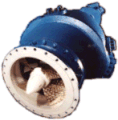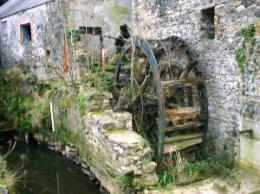 |
A water turbine converts fast moving water into mechanical
energy. Much like other turbines, it is basically a fan blade attached
to a shaft. Water pushes on the blades, making the turbine spin. |
| The earliest method of converting natural energy
into useful mechanical energy was the waterwheel. As early as 85 BC, the
Greeks were using waterwheels to grind corn. Until the invention of the
steam engine in the 18th century, the waterwheel was the primary mechanism
for power production. |
 |
That's one of the main reasons that many towns were
built next to flowing rivers. They were used to grind grain, power sawmills
and pumps, drive bellows for furnaces and forges, run hammers for forging
steel and spin yarn at textile mills.
During the 19th century, water turbines started to replace
waterwheels, however even to this day, there are thousands of waterwheels
still in operation.
Let’s take a look at how hydroelectric power is generated
with water turbines. |